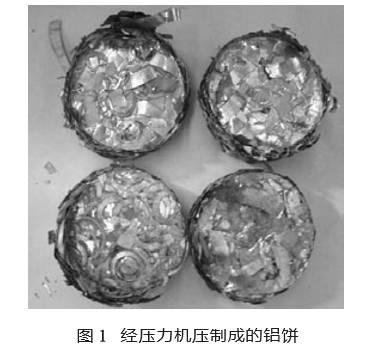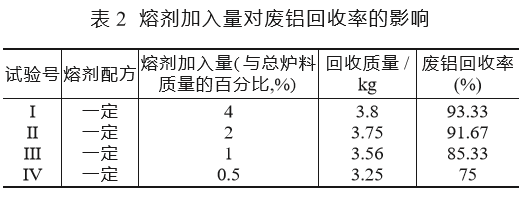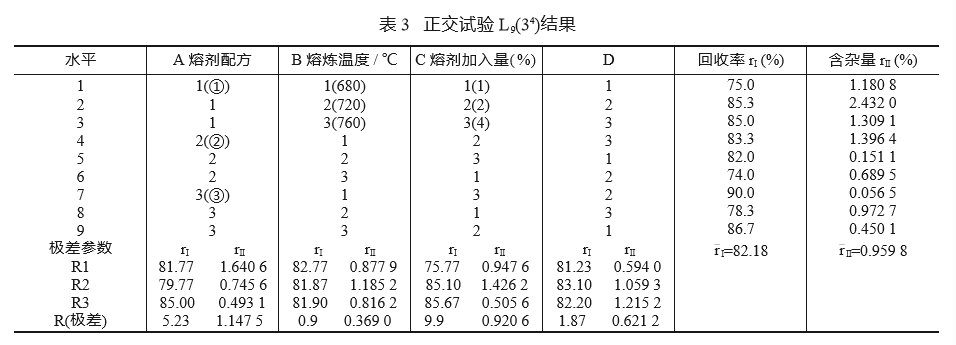As the consumption of aluminum alloys increases year by year, the amount of waste aluminum generated will also increase. These waste aluminum materials will be melted and reused to increase their recovery rate, which will help to save resources and energy. It has significant economic and social benefits. . Â
In recent years, scrap aluminum recycling has attracted attention from many metallurgical foundry workers at home and abroad, and scrap aluminum recycling technology has also been continuously improved. The smelting of scrap aluminum is a key part of the scrap aluminum regeneration technology, and the merits of the smelting technology are determined to a large extent by the flux used in the smelting process and its corresponding treatment process. In this paper, aluminum scrap is taken as the research object, and the effects of flux ratio, melting temperature, and flux addition on the purification effect are investigated to determine the optimal comprehensive parameters. Â
1 test conditions and detection methods
1.1 Raw Materials and Equipment
The raw material for the test was aluminum chips machined and machined from aluminum castings. The specific surface area was large, and the surface oxidation, corrosion, and oil-water contamination were serious. Â
The auxiliary non-toxic refining agent consists of sodium nitrate, graphite powder, cryolite, sodium chloride and the like. 0.5% of total charge weight per test
The smelting equipment is a 5 kW pit type experimental resistance furnace and a capacity of 5 kg cast iron crucible. Â
1.2 Detection methods
Determination of scrap aluminum recovery: The percentage of recycled aluminum weight (the total weight of aluminum recovered minus the weight of the alloyed aluminum billet put into smelting) and the weight of the charged pellets (the weight of the scrap aluminum billet charged during smelting) is called the recovery rate. Â
Determination of impurity content: Metallographic analysis software used to determine the percentage of the area occupied by impurities in each metallographic photograph, and then averaged all the metallographic photographs of the same sample as the impurity content of the sample. Â
Metallographic observation and photographing were performed under an XJG-05 metallographic microscope. Â
2 test methods
2.1 Preparation of flux
The flux tested consists of KCl, NaCl and several types of fluoride salts. Â
KCl and NaCl are the most common basic constituents of aluminum alloy fluxes and mainly act as covering agents. Therefore, KCl and NaCl are selected as their main components, and the addition of a small amount of fluoride salts in the mixture of chlorine salts is mainly responsible for the role of cleaning agent. . At the same time, the chlorine salt can also enhance the ability of the cleaning agent to adsorb oxide inclusions. Â
The flux is prepared as follows:
(1) Proportioning flux Formulation of three ratios, see Table 1.
(2) Ingredients According to the formulation of Table 1, mix and then mix the ball mill for 6~8h to ensure that the materials are mixed uniformly and the particle size is appropriate.
 Â
Â
2.2 Aluminum shavings pretreatment
In order to obtain better quality aluminum scrap, it is necessary to pretreat the aluminum scrap before melting. Its main purpose is to remove the iron scrap, sand and oil contained in the aluminum scrap. Therefore, the permanent magnets are used to suck out the scraps in the aluminum scraps; the sand in the scrap scraps is sieved out with a sieve; the aluminum scraps are cleaned with detergent to remove oil stains. Finally, the aluminum scraps are dried in a drying oven.
Due to the large specific surface area of ​​the aluminum scrap, if the aluminum scrap is directly added into the crucible to melt during melting, the aluminum scrap is greatly oxidized and the aluminum recovery rate will be greatly reduced. Based on this, this paper adopts a press to compress waste aluminum scrap into a small aluminum cake as shown in Fig. 1 to reduce oxidation burn-out.

2.3 Smelting
The smelting process is as follows:
1 First, the crucible furnace, pouring spoon, scoop scoop, bell jar and casting mold shall be cleaned and preheated, preheated to about 200°C, brushed with paint, and then dried;
2 When smelting, first add 1kg of aluminum alloy ingot, heat it above the liquidus temperature and completely melt it, then gradually add scrap aluminum cake. The total weight of scrap aluminum cake added is 3kg. After adding the waste aluminum cake, add the prepared flux when the temperature of the molten aluminum reaches the smelting temperature of the test design, and continue to stir. When observing that the slag particle size changes from large to small, it can be removed when the powder is fine. Slag
After slagging, add auxiliary refining agent when controlling the temperature of the aluminum liquid to about 720°C. When bubbles do not rise and the slag inclusions float, remove slag quickly;
4 After removing the slag, immediately pour the sample and aluminum ingot. Â
2.4 Post-processing
(1) After the sample and the aluminum ingot are cooled, they are weighed and the scrap aluminum recovery rate is calculated.
(2) Sampling, coarse grinding, fine grinding, polishing of the poured sample, observation with a microscope, and analysis of the micrograph. Â
3 experimental results
3.1 Preliminary experiment
Since flux addition is one of the most important factors affecting the recovery rate of waste aluminum, experiments were first conducted on the amount of flux added. Taking into account the actual production costs, the amount of flux required should not be too large, generally not exceeding 5%, so four levels were chosen for experiments. The test results are shown in Table 2.

Experimental conditions: Add flux at or around 700°C, slag and cast at about 720°C.
Flux formulation: still composed of KCl, NaCl, and several types of fluoride salts.
From Table 2, it can be seen that the recovery rate is too low when the addition amount is 0.5%, the recovery rates of 4% and 2% are ideal, the recovery rate of 1% is also good, and it is found through observation that the flux amount is 0.5% to 4 At %, the recovery rate of aluminum scrap will increase with the increase of flux addition, but when the addition amount is large, the increase rate of recovery will decrease. In later experiments, the amount of addition was set to three levels: 4%, 2%, and 1%. Â
3.2 orthogonal optimization test
The flux formulation and regeneration process are optimized for testing. The flux is still composed of the above components, but an equal amount of the same formulation of non-toxic refining agent is added during the smelting process. The non-toxic refining agent consists of nitrate and graphite powder. Â
In order to give full play to the effect of flux filtration and regeneration of waste aluminum, the main purification process parameters such as flux formulation, melting temperature (ie, flux addition and slag temperature), and flux addition amount were selected, and three levels were selected for each parameter. L9 (34) orthogonal table for optimization experiments. Â
Flux formulation (A): Three formulations were designed: Formula 1 (A1), Formula 2 (A2), Formulation 3 (A3). Â
Smelting temperature (B): should not be too high, so as not to exacerbate the oxidation and pollution of aluminum scrap; nor too low, otherwise it is not conducive to the flux removal. Select temperature: 680°C (B1), 720°C (B2), 760°C (B3). Â
Addition of flux (C): The amount of addition was 1% (C1), 2% (C2), and 4% (C3).
Orthogonal test results are shown in Table 3.

The range analysis shows that the important order and the best combination of factors: rI is CAB and A3B1C3; rII is ACB and A3B3C3. After comprehensive consideration, the initial choice of the optimal combination is A3B1C3. Comparing the values ​​of R1, R2, and R3, we can see that A and C have a significant effect on rI and rII, and B has little effect on rI and rII. Â
In the range analysis of rI and rII, we found that RD > RB for B compared with error factor D. That is, the influence of error factors on recovery rate and impurity content is greater than the effect of smelting temperature. Therefore, it cannot be judged during the experiment. Smelting temperature has no effect on recovery and impurity content. For this purpose, supplementary tests will be conducted. Â
3.3 Supplementary test
In the supplementary test, the two parameters of the flux formulation and the flux addition are fixed as A3 and C3, and then the smelting temperatures of the two levels B2 and B3 are selected to be combined. The supplementary test results are shown in Table 4.

From the above comparison, it is known that the smelting temperature has little effect on the recovery and impurity content of the test, but it does not have no effect. Under almost the same experimental error, the A3B2C3 combination is optimal, and the A3B 3C3 combination is relatively the worst. Combination A3B1C3 Similar effect to combination A3B2C3. This also shows that when the smelting temperature is between B1 and B2 (between 680°C and 720°C), it has almost no effect on the test results. When the smelting temperature is relatively high (close to 760°C), it will be more obvious. The adverse effects. As the smelting temperature is about 760°C, the oxidation and pollution of aluminum scrap are exacerbated, resulting in a decrease in the recovery rate and an increase in the amount of impurities. Â
4 Conclusion
(1) The flux formulation and the amount of flux added have significant effects on the purification effect of aluminum scrap.
(2) The use of Formula 3 flux, smelting temperature of 720°C, and flux addition of 4% yields the best purification effect under orthogonal optimization test conditions, and at the same time greatly reduces costs while ensuring good cleaning results.
Smart Appliances,Smart Home Appliance,Mini Smart Kitchen Appliance,Smart System Home Appliance
ChangChun E-vida Technology Co.,ltd , https://www.evidatech.com
